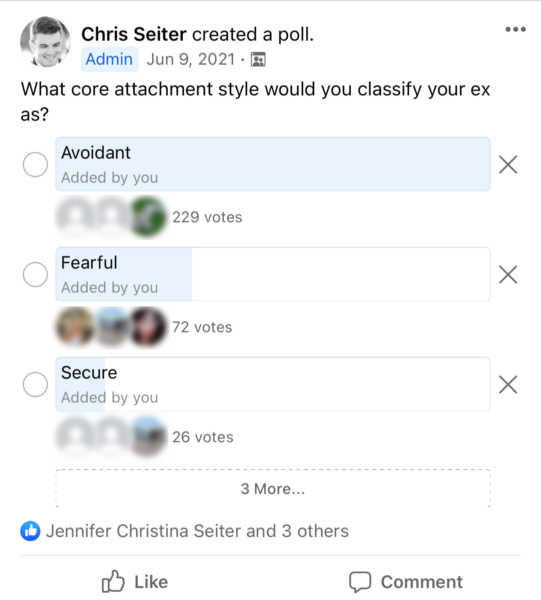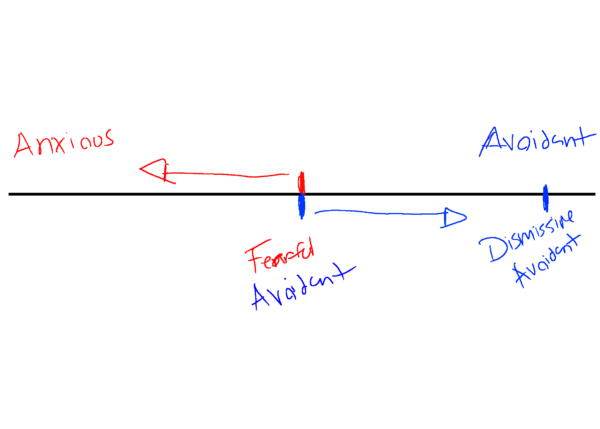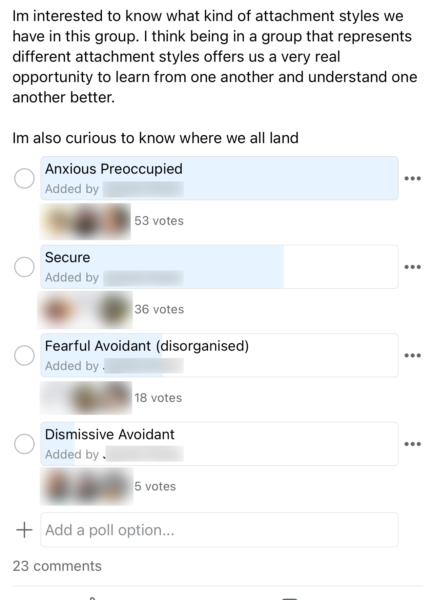Today we’re going to take a good hard look at how long it’ll take for a fearful avoidant ex to come back after a breakup.
Now, the obvious disclaimer is that there are no guarantees when it comes to things like this. However, I feel like I’ve done a good job at combining our own internal research with what we know to be true about fearful avoidants to at least give an honest accounting of how long you can expect fearful avoidants to come back.
Though it’s impossible to determine a precise timeframe for a fearful avoidant ex to come back, our average success story unfolds five to seven months after beginning our coaching. That’s usually with dismissive avoidant exes. For a true fearful avoidant ex, success seems happen much sooner, provided you’re doing everything correctly.
In this discussion we’ll be talking about things like,
- How to identify if your ex is fearful avoidant
- Why it’s important to understand the concept of deactivation
- Looking at the average success story time frame for exes to establish a baseline
- Hyper analyzing my last success story (whose ex was a fearful avoidant)
Let’s begin!

What Are Your Chances of Getting Your Ex Boyfriend Back?
Take the quizIdentifying If Your Ex Is A Fearful Avoidant
Here’s what the data tells us.
Most of the exes we study at Ex Boyfriend Recovery aren’t typically what we’d call ‘fearful avoidants’. Instead, they’re more often ‘dismissive avoidants’.
Knowing the difference between the two is key.
A fearful avoidant person grapples with two key struggles or as our very own Coach Tyler likes to call them, “core wounds,”
- They have an ‘anxious’ core wound, which makes them fear being left alone.
- And they have an ‘avoidant’ core, which makes them scared of losing their independence.
This forms a sort of paradox.
This is why it can seem like a fearful avoidant is constantly battling with themself. From an outsider’s perspective, it can look a bit like they have multiple personalities.
One minute they’re all in on the relationship, super passionate, and the next, they’re as cold as ice.
But what’s really going on inside them is that they’re either being triggered by their anxious core wound or their avoidant one.
But here’s the kicker – most people aren’t fearful avoidants.
In fact, recent studies suggest that only about 7% of the population can be classified or diagnosed as having a fearful avoidant attachment style.
So, how do you tell?
How You Can Tell Your Ex Is A Fearful Avoidant
Generally you are looking for two things,
- Their childhood
- The concept of deactivation
- Looking at their behavior.
Let’s start with the childhood bit first.
Taking A Look At A Fearful Avoidants Childhood
Well, the first step I’d suggest is to take a look at their childhood.
If you suspect your ex is a fearful avoidant, generally speaking, you’d be looking for instances of trauma, neglect, and the like in their upbringing.
It can be quite nuanced, though.
A person could have had a fantastic relationship with their parents, who might themselves be secure individuals. But if that person grew up in a war zone and, as a child, saw their parents – who are loving, attentive individuals – in a constant state of anxiety and distress, that could lead to a fearful avoidant attachment style.

What Are Your Chances of Getting Your Ex Boyfriend Back?
Take the quizObserve their Behavior
- People Pleasing and Agreeableness: Fearful avoidants may people please and be agreeable early on, but they also have strong opinions and are not quick to repress them to be agreeable. They may be agreeable to requests or suggestions for the next date, but they stick to their opinions.
- Avoiding Vulnerability: Fearful avoidants try not to appear weak, needy, or vulnerable early on in a date. They may mention how independent they are, how they’re taking their time with dating, and how they don’t need someone in a relationship. They may do this because they think it’s desirable or attractive, or because they have fears of relying on someone.
- Open Body Language: Fearful avoidants tend to have open, attuned body language. They focus on making eye contact and paying attention to what their date is saying. They ask deep questions about their date but are hesitant to share too much about themselves early on.
- Directness: Fearful avoidants tend to be quite direct. If they’re interested, they will tend to jump in headfirst. However, they may get cold feet in the big commitment stages.
- Deflecting Compliments: If given too many compliments early on, fearful avoidants tend to deflect or shrug off compliments. This could be because they’re afraid to feel too vulnerable or because they have a programmed sense of unworthiness.
I think it’s also crucial to grasp the concept of ‘deactivation’.
Look For The Concept Of Deactivation
When a fearful avoidant feels triggered, they might feel an overwhelming urge to either withdraw or react aggressively.
To put it in perspective, imagine the fearful avoidant on a spectrum.
When they feel an overpowering need to withdraw, it usually suggests their avoidant side is being triggered.
Conversely, if they feel a strong impulse to react aggressively and take control, it typically signals their anxious side is being stirred up.
There are numerous reasons why this can happen.
- It could be a reaction to perceived criticism.
- Maybe they feel as if they’ve been abandoned.
- Or perhaps there are unexpected attempts at establishing a closer connection with them.
Notice how these are all triggers that elicit either the fear of losing independence from the avoidant side or the fear of abandonment from the anxious side.
You’ll also notice that fearful avoidants often experience something called ‘negative sentiment override’. This means that they interpret neutral or even slightly negative interactions as wholly negative, further affirming their belief that the world is against them. So, with fearful avoidants, you’re mainly looking for these trigger points. This notion of ‘deactivation’ is essentially about identifying these triggers.
But what does all this tell us about the time it takes for a fearful avoidant ex to return?
Looking At Our Average Success Story
You might naturally assume it would be a lengthy process.
Surprisingly, that’s not always the case.
When we examine our success stories, the average client who enlists our coaching services typically gets their ex back around five to seven months after they begin working with us. It could happen sooner or later; it varies.
Here’s a quick video I did that breaks it down,
Now, keep in mind that most of the exes our clients are attempting to win back are dismissive avoidants.
This usually means they require longer periods of no contact, and our clients need to exercise more restraint, among other things.
However, fearful avoidants tend to come back more quickly.
Why is that? I believe it’s due to the concept of deactivation and the fact that their anxious side can be activated.
Consider this: a fearful avoidant person has two main fears – a fear of abandonment and a fear of losing their independence.
Generally, when dealing with the avoidant fear – the fear of losing independence – it tends to take longer to reconcile.
But here’s the fascinating part: fearful avoidants can get their anxious side triggered.
Typically, the people who approach us for our services, trying to get their exes back or move on from their ex, are quite anxious. They’re desperately seeking a solution, terrified of being abandoned.

What Are Your Chances of Getting Your Ex Boyfriend Back?
Take the quizThat’s why I think fearful avoidants are easier to win back, although they might be harder to keep.
So, when that anxious side of a fearful avoidant gets triggered, that’s when you typically see them come back.
What We Can Learn From A Real Fearful Avoidant Success Story
To illustrate this, let me share the story of the last person I coached.
I wear many hats here at Ex-Boyfriend Recovery.
- I create content for articles
- Record podcasts
- Film YouTube videos
- Manage our community
- Offer coaching.
Whenever a problem arises, I’m usually the one that has to find a solution. As a result of this, coaching spots with me are limited.
On average, I only have between three to eight spots a month with me dedicated to coaching.
During the month this story takes place, I had just released my calendar.
Eight spots were available.
A man reached out, eager to reconcile with his ex-girlfriend. He was incredibly anxious and, to emphasize his determination, he purchased all eight coaching sessions in a single day.
That was a first for me, considering coaching isn’t cheap.
- During our first session, he was convinced his ex was a dismissive avoidant.
- After asking some probing questions about her behavior, I disagreed. I believed she was a fearful avoidant.
- Despite his initial resistance, I explained the concept of fearful avoidance, the two core wounds, and the significance of catering to their anxious side when triggered.
- I also stressed the need for a no-contact period, though shorter than usual, and recommended a 21-day rule.
Throughout the beginning of the no-contact rule, my client consistently expressed skepticism about his ex reaching out.
The end of their relationship was bitter, and he didn’t think she would ever want to talk to him again. I kept reassuring him to be patient. Slowly but surely, signs of her anxious side being triggered started appearing.
She made subtle digs at him on Instagram, liked some of his posts, but never commented. He resisted the urge to reach out to her, adhering to my advice.
Seven days into the no-contact period, she texted him directly, asking to meet.
I advised him against it since he still had 14 days of no-contact left.
However, he went against my advice, met up with her, and walked out of that meeting back in a relationship.
Why?
Her anxious side had been triggered. Even though he broke the no-contact rule early, it worked.
In my opinion, it was successful because of her fearful avoidant attachment style and the need for that anxious side to be nurtured.
What This Experience Can Teach Us
This experience taught us several things.
- First, fearful avoidant exes come back more quickly than anticipated.
- Second, once their anxious side gets triggered, it needs to be nurtured.
- Lastly, mirroring, particularly with a fearful avoidant, is crucial.
When his ex asked for space, he gave it to her. This allowed her anxious side to surface, which he then nurtured, and voila, they got back together.
Looking back, I still think he should’ve waited the full 21 days. Subsequent experiments with this method revealed it’s usually not in your best interest to break no-contact too early.
Instead, letting the 21 days pass and then reaching out is more beneficial. It’s crucial for them to experience those fluctuations in emotional value, swinging between wanting to talk to you and not.

What Are Your Chances of Getting Your Ex Boyfriend Back?
Take the quizThough it’s impossible to determine a precise timeframe for a fearful avoidant ex to come back, our average success story unfolds five to seven months after beginning our coaching. That’s usually with dismissive avoidant exes. For a true fearful avoidant ex, success seems happen much sooner, provided you’re doing everything correctly.



aly
October 28, 2025 at 7:43 pm
My ex and I were together 4 years and we started off as best friends. Recently we have been arguing more than usual, primarily about the lack of romance and how he became so complacent. He suggested a breakup since we had been arguing more often and he felt it was unhealthy and I agreed so it was mutual but we left off on amicable terms. A week after the breakup he wanted to meetup to get clarity and seemed to want to work things out only to retract that the following day. He said his mind and heart weren’t aligning and hes uncertain and would rather focus on self growth before giving himself to someone. He expressed feeling broken. To spare both of us I suggested no contact until he can figure out how he feels. how long should i wait to reach out or expect him to?